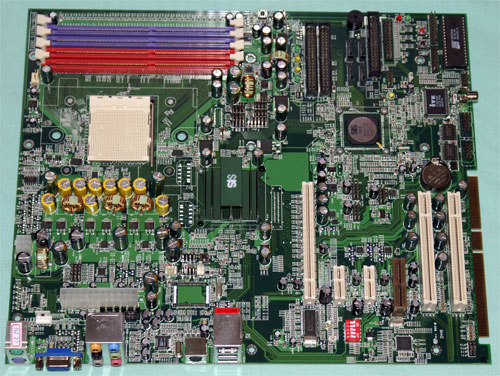
Original Link: https://www.anandtech.com/show/1789
SiS 756: PCI Express for AMD Socket 939
by Wesley Fink on September 13, 2005 12:05 AM EST- Posted in
- CPUs
There is no doubt that NVIDIA's nForce4 chipset is the standard against which AMD Socket 939 chipsets will be measured. AMD has become the leading enthusiast platform and NVIDIA's chipset fortunes have risen while VIA has continued to struggle in this arena. There are many companies who want a piece of that growing chipset pie, however, ranging from large players like ATI to relative newcomers like ULi.
In recent weeks, we have been looking at these contenders. The first production ATI board aimed at the enthusiast was reviewed in Sapphire PURE Innovation - ATI's Chipset for the AMD Enthusiast . The Multi-GPU ATI Crossfire board will launch later this month. ULi provided two generations of Socket 939 PCIe Reference boards in FIRST LOOK: ULi M1695 PCIe/AGP Socket 939 for Athlon 64 and ULi M1695 PCIe/AGP for Athlon 64 - Part 2 with SLI. This led to a review a few days ago of the first production ULi M1695/M1567 in ASRock 939Dual-SATA2: First Retail ULi PCIe/AGP. Since we found many good things in the new Socket 939 chipsets, we decided to take a closer look at another contender - the SiS 756 chipset.
The SiS 756 is an upgrade to the SiS755FX chipset that we reviewed last December. Where the 755FX was PCI/AGP, the SiS 756 was to feature the PCI Express bus with PCIe graphics. The SiS 756 first appeared as Reference samples to reviewers many months ago, but the retail products have taken a long time to appear in the market. Our readers will likely advise us of other offerings, but almost 6 months after review samples, we could only find one production SiS 756 board, the ASRock 939S56-M, and even it is difficult to find. We also discovered that the ECS PF88, the ECS modular CPU board discussed in Editors Day 2005: A "NEW" ECS Looks to the Future, uses the SiS756 on the A9 add-on module for Socket 939. We could not find any other current production boards using the SiS 756 chipset.
So, how does SiS 756 compare to nForce4, ATI Rx480, and ULi 1695? Is performance on par with the best Socket 939 chipsets? Are features competitive in the Socket 939 universe?
The SiS Chipset Family
To provide answers to our questions, we started with a closer look at the current family of SiS chipsets. SiS provides chipset for both Intel and AMD processors that support PCI Express. Both chipsets are composed of separate North and South bridges. The SiS Intel family consists of 4 north bridges: the 649, 649FX, 656, and 656FX.
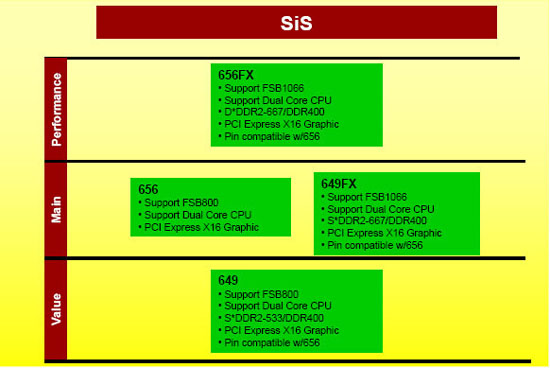
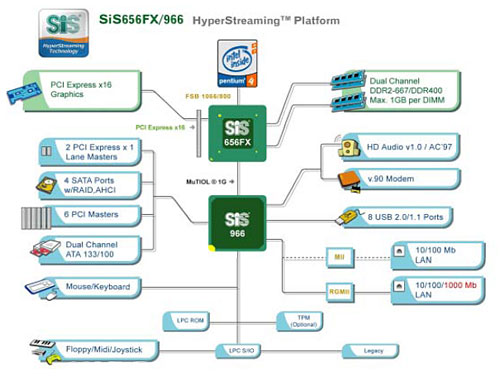
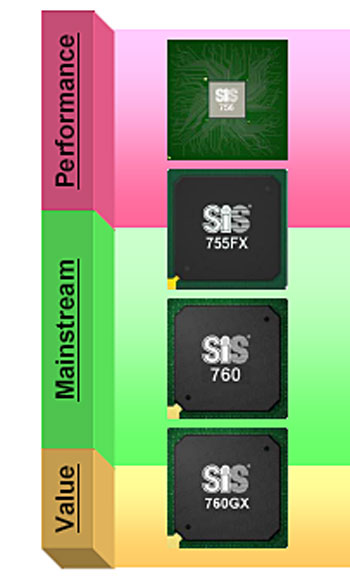
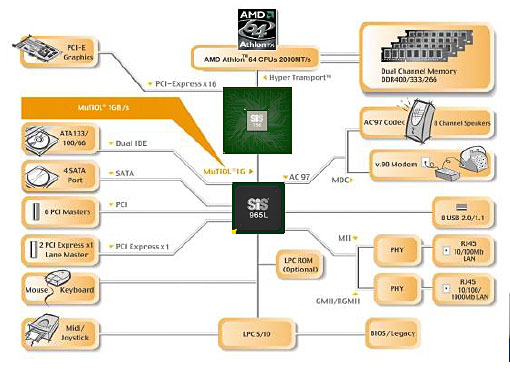
| Product Name | SiS965 | SiS965L | SiS966 | SiS966L |
| NB/SB Interconnection Type: | MuTIOL® 1G | MuTIOL® 1G | MuTIOL® 1G | MuTIOL® 1G |
| Bandwidth: | 1GB/s | 1GB/s | 1GB/s | 1GB/s |
| Data Bus Speed: | 533MHz | 533MHz | 533MHz | 533MHz |
| PCI Express/Ports: | PCIe x1/ 2 | PCIe x1/ 2 | PCIe x1/ 2 | PCIe x1/ 2 |
| Serial ATA/ Ports: | SATA150/ 4 | SATA150/ 2 | SATA150 AHCI/4 | SATA150 AHCI/2 |
| Parallel ATA/ Devices: | ATA133/4 | ATA133/4 | ATA133/4 | ATA133/4 |
| RAID | 0,1,0+1,JBOD | 0,1, JBOD | 0,1,0+1,JBOD | 0,1, JBOD |
| USB/ Ports: | 2.0/ 8 | 2.0/ 8 | 2.0/ 8 | 2.0/ 8 |
| PCI/ Devices: | 2.3/6 | 2.3/6 | 2.3/6 | 2.3/6 |
| LAN: | 10/100/1000Mb/s | 10/100Mb/s | 10/100/1000Mb/s | 10/100Mb/s |
| Audio: | AC'97 | AC'97 | AC'97/HDA | AC'97/HDA |
| SiS PCI Serial ATA Solution: | SiS180 | SiS180 | SiS180 | SiS180 |
The number difference reflects Audio, with the 965 supporting AC'97 and the 966 supporting High-Definition (Azalia) audio or AC'97. The "L" designates lower cost and fewer features, like native 10/100 LAN instead of Gigabit LAN, and fewer SATA ports.
Basic Features: SiS 756 Reference Board
| SiS 756 Reference Board | |
| CPU Interface | Socket 939 Athlon 64 |
| Chipset | SiS 756 Northbridge - SiS 965L Southbridge |
| CPU Clock Speeds | 200 to 255MHz in 1MHz Increments |
| Memory Speeds | Auto, DDR200, 266, 300, 366, 400 |
| PCIe Speeds | 80, 85, 90, 91, 94, 97, 100 |
| PCI/AGP | Fixed at 33/66 |
| Core Voltage | Auto, 1.175V to 1.55V in 0.025V increments |
| CPU Clock Multiplier | 8x-23x in 1X increments |
| DRAM Voltage | NO Adjustments |
| HyperTransport Frequency | 1000MHz (1GHz) |
| HyperTransport Multiplier | Auto, 200, 400, 800, 1000 (NO 600 Setting) |
| HyperTransport Voltage | None |
| Chipset Voltage | None |
| Memory Slots | Four 184-pin DDR DIMM Slots Dual-Channel Configuration Regular Unbuffered Memory to 4GB Total OR Registered DIMMs if Selected in BIOS |
| Expansion Slots | 1 PCIe x16 2 PCIe x1 2 PCI Slots |
| Onboard SATA/RAID | 4 SATA 1 Drives by 965L (RAID 0, 1, JBOD) |
| Onboard IDE/IDE RAID | Two Standard ATA133/100/66 (4 drives) |
| Onboard USB 2.0/IEEE-1394 | 8 USB 2.0 ports supported by 965L NO Firewire |
| Onboard LAN | Gigabit PCIe Ethernet by SiS191/190 Driver |
| Onboard Audio | 7.1 AC'97 Audio by Realtek ALC850 |
| BIOS | AMI |
In Reference Board reviews, there is always the mention that Reference Boards are designed for qualification and not for production. This is particularly true with the SiS 756 Reference Board as it was not even designed to fit in a standard case.
The SiS 756 Reference Board is more typical of Reference Boards from the past than some of the recent ones that we have tested. ULi and ATI both supplied boards with a complete range of overclocking options and a design that supported overclocking. The SiS 756 is much more modest - more for qualification than any evaluation of enthusiast level performance.
200 to 255 is too limited in processor clock speed to interest the enthusiast, though it is more than adequate for the average user who may never overclock his motherboard. Particularly troublesome is the missing 600 Hypertransport setting, which is useful in higher overclocks. Voltage is also limited to a modest .05V over-volt with a 130nm Athlon 64.
The 965L south bridge supported a Realtek ALC850 7.1 channel codec that is commonly seen on AMD chipsets. However, the more recent 966 south bridge, combined with the 756, could provide High-Definition (Azalia) audio, like the recently tested ATI Rx480 chipset. This would be a real advantage compared to the basic audio capabilities of the nForce4 chipset.
You will also notice that while the 965L supports SATA and SATA RAID, it does not support SATA2. This may or may not matter to you. SATA2, and in particular SATA2 3.0Gb/s drives, are just now appearing on the market. The new SATA2 drives, even the 3Gb/s variety, offer little performance advantage today, so this may not of importance to you. However, this will likely become a more important feature over time.
It is also worth noting that SiS has not yet announced a Southbridge with SATA2 support. Even the 966 family does not fully support SATA2. The next generation south bridges will likely support this feature.
Overclocking: SiS 756 Reference Board
| SiS 756 Reference Board | |
| Overclocking Testbed | |
| Processor: | Athlon 64 4000+ (2.4GHz, 1MB Cache) |
| CPU Voltage: | 1.55V (default 1.50V) |
| Cooling: | Thermaltake Silent Boost K8 Heat sink/Fan |
| Power Supply: | OCZ Power Stream 520W |
| Memory: | OCZ PC3200 Platinum Rev. 2 (Samsung TCCD Memory Chips) |
| Hard Drive: | Seagate 120GB 7200RPM SATA 8MB Cache |
| Maximum OC: (Standard Ratio) |
220*x12 (4x HT, 2.5-3-3-8) 2640MHz (+10%) |
| Maximum FSB: (Lower Ratio) |
220* x 9 (4x HT, 1T) (2640MHz, 2 DIMMs in DC mode) (+10% Bus Overclock) |
It wasn't enough that the settings for testing overclocking were very limited on the SiS 756. The board artificially set higher clock settings back to 220. We thought that we were testing at 233 CPU clock until we ran CPU-Z, which told us that the board was running at 12 times a clock frequency between 219.5 and 220.3. SiS would have been better to let the board fail overclocking naturally instead of manipulating clock frequencies.
This same phenomenon was seen when we tried to lower multipliers and crank up to the board max frequency of 255. The SiS 756 Reference either dropped to 220 or lowered the multiplier to 133 or both. As a result, we could find no way to clock higher than 220 (+1-%) at any ratio. All-in-all, this was one of the most disappointing performances that we have seen in overclocking a Socket 939 board. Perhaps SiS is actually shipping 756 chipsets with better OC potential. We certainly hope that they are.
TRas and Memory Stress Testing
Memory tRAS Recommendations
In past reviews, memory bandwidth tests established that a tRAS setting of 11 or 12 was generally best for nForce2, a tRAS of 10 was optimal for the nForce3 chipset, a tRAS of 7 was optimal for the nForce4 chipset, the ULi 1695 was best at tRAS of 10, and ATI is best at 7 to 8.
Since this is our first review of the SiS 756 chipset, tRAS timings were first tested with memtest86, a free diagnostic program with its own boot OS that will boot from either a floppy disk or optical disk. Bandwidth of OCZ PC3200 Platinum Rev. 2, based on Samsung TCCD chips, was measured from tRAS 5 to tRAS 13 to determine the best setting.
| Memtest86 Bandwidth SiS 756 Reference Board with Athlon 64 4000+ |
|
| 5 tRAS | 1954 |
| 6 tRAS | 1954 |
| 7 tRAS | 1995 |
| 8 tRAS | 2039 |
| 9 tRAS | 2039 |
| 10 tRAS | 1995 |
| 11 tRAS | 1995 |
| 12 tRAS | 1875 |
| 13 tRAS | 1875 |
Two things stood out in our tRAS tests. First, the SiS 756 exhibits the best bandwidth at a tRAS setting of 8 or 9. We decided to use 8 for all our testing. Second, the bandwidth numbers on the SiS 756 were lower across the tRAS tests than what we have seen with the NVIDIA nForce4 and the ATI Rx480. This points to SiS having a poorer front end to the AMD on-chip memory controller than either nForce4 or ATI Rx480 - at least at this stage of development.
Memory Stress Test
Our memory stress test measures the ability of the SiS 756 to operate at its officially supported memory frequency (400MHz DDR), at the lowest memory timings that OCZ PC3200 Platinum Rev. 2 modules will support. All DIMMs used for stress testing were 512MB double-sided (or double-bank) memory. To make sure that memory performed properly in Dual-Channel mode, memory was only tested using either one dual-channel (2 DIMMs) or 2 dual-channels (4 DIMMs).
| Stable DDR400 Timings - One Dual-Channel (2/4 DIMMs populated) |
|
| Clock Speed: | 200MHz |
| CAS Latency: | 2 |
| RAS to CAS Delay: | 2T |
| RAS Precharge: | 8T |
| Precharge Delay: | 2T |
| Command Rate: | 1T |
Using two DIMMs in Dual-Channel 128-bit mode, the memory performed in all benchmarks at the fastest 2-2-2-8 timings at default voltage, which was the only memory voltage available.
| Stable DDR400 Timings - 4 DIMMs (4/4 DIMMs populated) |
|
| Clock Speed: | 200MHz |
| CAS Latency: | 2.0 |
| RAS to CAS Delay: | 2T |
| RAS Precharge: | 8T |
| Precharge Delay: | 2T |
| Command Rate: | 2T |
Tests with all four DIMM slots populated on the SiS 756 required a 2T Command Rate with 4 DIMMs in two dual channels. This is the pattern seen on other top-performing Socket 939 boards. Since the Athlon 64 memory controller is on the processor, there were no real surprises in the memory stress tests.
Test Setup
| Performance Test Configuration | |
| Processor(s): | AMD Athlon 64 4000+ (2.4GHz) Socket 939 |
| RAM: | 2 x 512MB OCZ PC3200 Platinum Rev. 2 |
| Hard Drive(s): | Seagate 120GB 7200 RPM SATA (8MB Buffer) |
| Video AGP & IDE Bus Master Drivers: | NVIDIA nForce 6.66 Uli Gart for AGP only |
| Video Cards: | NVIDIA 6800 Ultra |
| Video Drivers: | NVIDIA nForce 77.77 |
| Operating System(s): | Windows XP Professional SP2 Direct X 9.0c |
| Motherboards: | SiS 756 Reference Board ASRock 939Dual-SATA2 (ULi M1695/1567) Sapphire A9RX480 (ATI) Jetway 939GT4-SLI-G (nForce4) ULi AP9567A (M1695/M1567) DFI LANParty UT nF4 Ultra-D (nForce4) MSI K8N Neo4/SLI Platinum (nForce4) |
Tests used OCZ PC3200 Platinum Rev. 2, which uses Samsung TCCD chips. All memory ran at 2-2-2-8 timings in all benchmarks.
The NVIDIA 6800 Ultra was used for testing both PCIe and AGP performance on the ASRock board and the ULi Reference board. The 6800 Ultra video cards were tested at the same video timings and differed only in interface - AGP or PCIe. Resolution in all benchmarks is 1280x1024x32 unless otherwise noted.
SiS claims full Athlon64 X2 compatibility on their website. We were able to confirm that claim in brief operation tests with an A64 4800+. Benchmarks were run with the 4000+ 130nm A64 for benchmark comparison with other Athlon64 board reviews.
Results for the ULi chipset boards are in light blue for AGP and blue for PCIe.
General Performance and Encoding
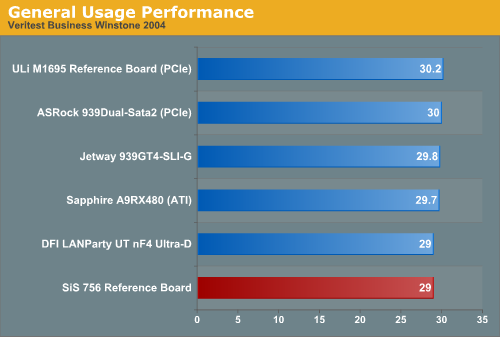
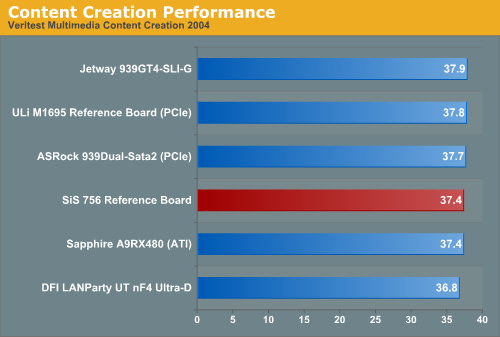
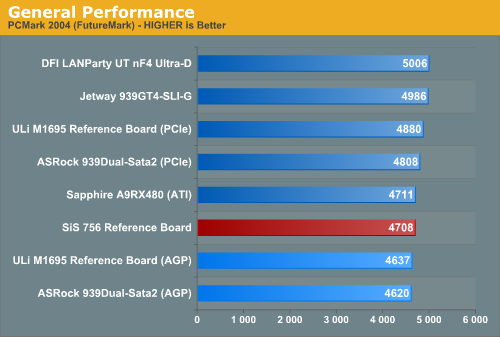
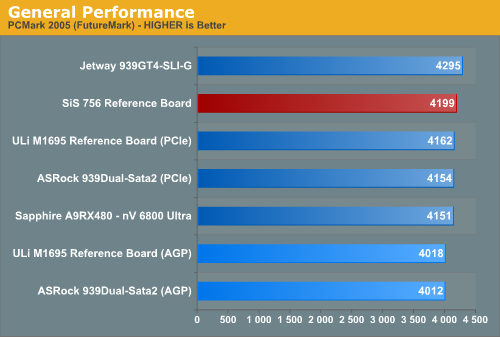
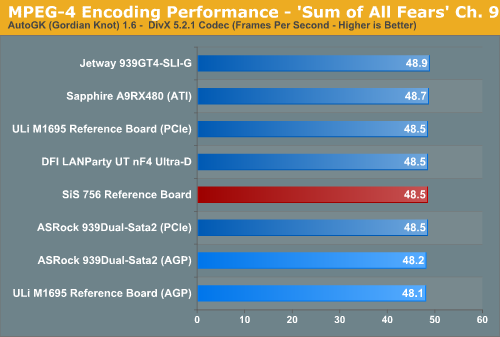
As we have seen so many times before on Athlon 64 benchmarks, moving the memory controller to the processor has presented us with very tight benchmark ranges. Here, we have 4 different chipsets and we still have a very small variation in any of the test results.
This small variation in Benchmark results in General Performance and Encoding means buyers can choose Athlon 64 boards based on features and/or price. They can still be confident that the board and chipset that they get will perform competitively. That is good news for those in the market for a new motherboard.
One small hiccup in the overall results was performance of the SiS 756 in PCMark. In the 2004 version, the SiS chipset was among the worst performers, while in the 2005 version, it rises to one of the best performances.
Overall, there is little to distinguish or detract from the SiS 756 in General Performance and Encoding. The SiS is competitive with the best Socket 939 Athlon 64 boards that we have tested.
Gaming Performance
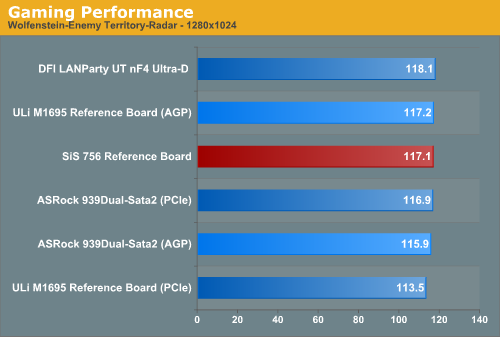
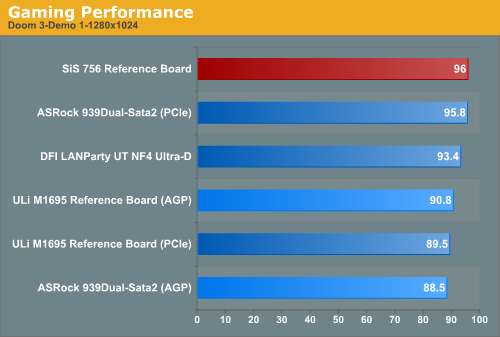
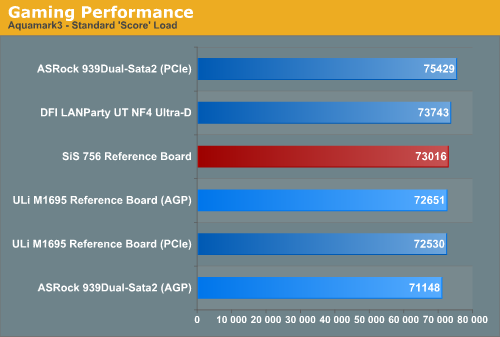
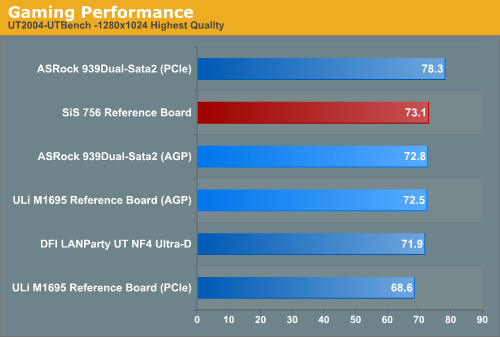
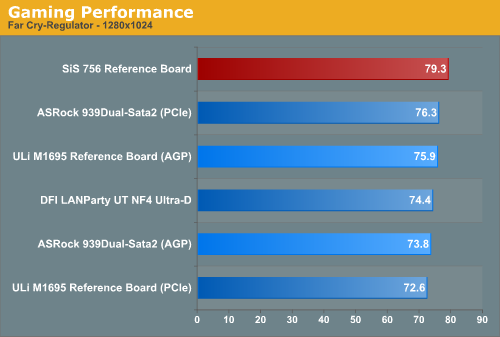
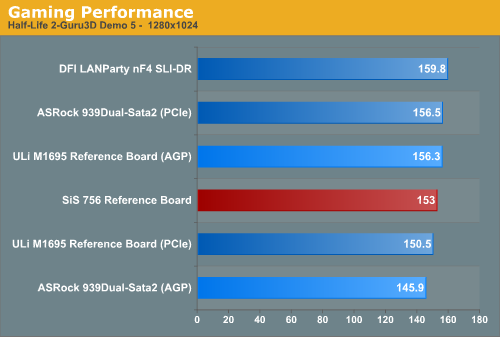
Overall, the SiS 756 is competitive in gaming among tested Socket 939 chipsets. It seems that all of the 939 chipset makers have done a decent job with performance of their chipsets. As a buyer, you will need to look at features, performance of features, and overclocking performance to distinguish among the chipsets that we have tested.
Ethernet Performance
The new motherboard test suite, launched earlier this year, includes LAN performance measurements. The test procedure that we use was first described in a VIA white paper.
The Windows 2000 Driver Development Kit (DDK) includes a useful LAN testing utility called NTttcp. We used the NTttcp tool to test Ethernet throughput and the CPU utilization of the various Ethernet Controllers used on the various nForce4 and ATI motherboards. We did not test the ULi M1695/M1567 Ethernet controller since ULi only provides 10/100 performance on their LAN controller.
We set up one machine as the server; in this case, an Intel box with an Intel CSA Gigabit LAN connection. Intel CSA has a reputation for providing fast throughput and this seemed to be a reasonable choice to serve our Gigabit LAN clients. At the server side, we used the following Command Line as suggested by the VIA whitepaper on LAN testing:
NTttcps -m 4 ,0,On the client side (the motherboard under test), we used the following Command Line:-a 4 -l 256000 -n 30000
NTttcpr - m 4 ,0,At the conclusion of the test, we captured the throughput and CPU utilization figures from the client screen.-a 4 - l 256000 - n 30000
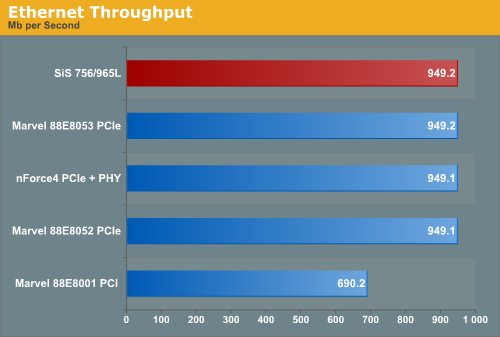
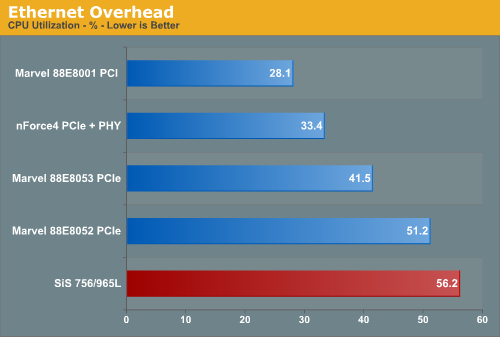
Please keep in mind that CPU utilization measurements for Gigabit Ethernet can be somewhat misleading, since they measure the percentage of CPU tie-up at sustained Gigabit receiving. In reality, it would be very rare that you would actually see sustained Gigabit transmission levels on your PC. For that reason, you should put the measured CPU utilization of Gigabit PCIe LAN in perspective. It will almost always be much lower than what we have measured.
Final Words
The SiS 756 competes very well in performance benchmarks at stock speeds. We found little in our Benchmark tests that would sway us for or against the SiS 756 chipset. However, when we look at the broader picture of features, the SiS 756 is clearly on the short end of the stick.
Not only will you not find Firewire or SATA2 or SLI on the SiS756, you will also find overclocking performance among the worst that we have yet measured on a Socket 939 board. That won't matter to you if you never overclock and never intend to, but it will matter to many Athlon 64 buyers who consider themselves to be enthusiasts.
SiS did have the foresight to include Gigabit LAN in their chipset, something ULi overlooked in their M1695/M1587 chipset. It is also good news that the SiS chipset Gigabit LAN is more than just a checklist add-on. Performance of the PCIe based Gigabit LAN is as good as we have measured, though the CPU overhead is a bit higher than what we like to see.
Audio on the older 965L south bridge is the below average AC'97 seen on the nForce4 chipset. This is clearly not up to the new audio performance leaders in the AMD world - ATI and ULi with their high performance Azalia audio. Fortunately, manufacturers can correct this very soon by combining the 956 south bridge with a 756 to deliver High Definition Azalia audio to SiS 756 customers. This leaves NVIDIA, the AMD chipset leader, in an embarrassing position. After pioneering top-notch on-board audio with their nForce2 chipset, they will soon be the only Athlon 64 chipset maker without High Definition audio.
The SiS 756 is competitive in performance and moderate on features. Future plans for additional south bridges show that SiS has plans in the works to bring even more features to this chipset with new south bridge choices. Having said this, we wonder why it is next to impossible to find the SiS 756 chipset on retail motherboards almost 6 months after Reference Boards shipped. SiS, through either their Marketing efforts or their actual performance on contracts, appears to be failing to capture the confidence of board makers. With competitive chipset performance, someone in SiS needs to be asking questions and finding answers as to why so few manufacturers will build new boards with a SiS chipset. Unless SiS finds these answers soon, they may find themselves pushed out of the chipset market by aggressive new players.

